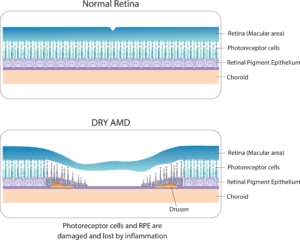What is Wet Macular Degeneration?
Have you heard of macular degeneration? You may have yet to realize that there are two kinds of it: dry and wet.
The most common kind of macular degeneration is the dry form. Wet macular degeneration only affects 10 percent of people with macular degeneration.
However, it’s the most aggressive form of this eye condition. It’s also a leading cause of permanent vision loss among older adults aged 50 and above in the U.S.
Prompt diagnosis and treatment can help manage the condition and preserve your remaining eyesight. Keep reading to learn more about the difference between wet and dry macular degeneration and treatment options for wet macular degeneration.
Wet vs. Dry Macular Degeneration
To better understand the difference between wet and dry macular degeneration, it’s essential to know what macular degeneration is. Macular degeneration is a chronic eye condition that slowly destroys your central vision.
It’s usually linked to the normal aging process. However, other factors can also increase your risk of developing macular degeneration. They include:

- High blood pressure
- Being overweight
- Heart disease
- Smoking or exposure to secondhand smoke
- High cholesterol levels
- Too much exposure to the sun
- Family history of macular degeneration
Dry AMD is the most common type of macular degeneration. About 85 to 90 percent of patients with macular degeneration have dry macular degeneration. Dry macular degeneration occurs gradually and causes less damage to your vision.
Dry Macular Degeneration
In the dry stage of macular degeneration, yellowish clusters of proteins and fats called drusen accumulate beneath your macula. The macula is found at the very center of your retina.

It’s responsible for your ability to see straight-ahead and helps you see color and discern fine details. A build-up of drusen under your macula causes it to deteriorate with time.
Large or excess drusen affect your central vision and are tell-tale signs of dry macular degeneration. Early dry AMD may not affect your vision significantly, but advanced or late dry macular degeneration causes changes in your central vision.
Sometimes, abnormal blood vessels may begin growing under your retina if you have dry macular degeneration. If this occurs, it’s called choroidal neovascularization.
When it occurs, dry macular degeneration progresses to the rarer form, wet macular degeneration. In wet macular degeneration, abnormal, weak vessels cause blood and fluid to leak into the macula.
The leaking fluid and blood result in permanent macula scarring and damage to your central vision. Wet macular degeneration progresses much faster and leads to severe vision loss without treatment.
Signs of Wet Macular Degeneration
Some of the signs of wet macular degeneration include:

- Blurry vision
- Trouble seeing faces
- Straight lines looking crooked or wavy
- Dark spots or gaps in your vision
- Words appearing jumbled or distorted when reading
- Inability to see colors correctly and clearly
- Difficulty cooking, watching TV, driving, and performing other routine tasks
Wet Macular Degeneration Treatment
Some of the treatments used for wet macular degeneration include:
Anti-VEGF Injections
There is currently no cure for wet macular degeneration. But anti-VEGF therapy is very effective in controlling it and making it more manageable.
Anti-VEGF agents comprise a class of drugs that includes:
- Avastin (bevacizumab)
- Beovu (brolucizumab)
- Lucentis (ranibizumab)
- Eylea (aflibercept)
The deterioration of the macula in wet macular degeneration causes the retina to make a protein called vascular endothelial growth factor or VEGF. The retina creates the protein to protect itself and form new blood vessels.
However, the new blood vessels made don’t help because they’re abnormal and fragile. These vessels leak fluid and blood that destroy the macula.
With time, scar tissue forms on the macula, resulting in the irreversible loss of your central vision. Anti-VEGF is injected directly into your eye to prevent the growth of new, abnormal blood vessels.
It does this by blocking VEGF. Depending on your specific needs, the treatment is repeated every four weeks to every six months or longer.
During the treatment, your eye doctor will use a numbing agent to ensure you don’t feel any pain.
You may still experience slight pressure, but it goes away quickly.
The medication is then injected through the side of your eye, where you cannot see the needle.
It only takes seconds to inject the treatment into your eye. Anti-VEGF injections prevent vision from worsening in 9 out of 10 patients. It further improves vision in 3 out of 10 people.
Save Your Sight from Wet Macular Degeneration

Wet macular degeneration treatment at Eye Consultants of North Dakota works best if the condition is detected promptly. Treatment can help delay the progression of wet macular degeneration and protect your remaining vision.
Do you want to learn more about wet macular degeneration and how best to treat it? Schedule your appointment today with the experts at Eye Consultants of North Dakota in Fargo, ND, for an accurate diagnosis and best-in-class treatment.



